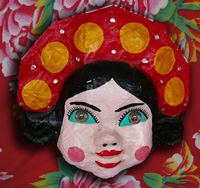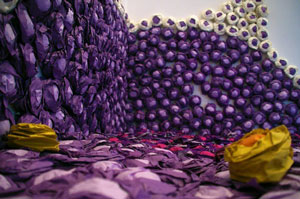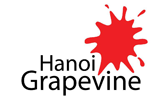KVT – Journeys with lines
 |  |
I’ve seen Vu Kim Thu’s installations at the Bui Gallery twice since the opening and the second viewing confirmed my appreciation of them.
The artist seems to work with a single concept, arranging, rearranging, forming and reforming until she lays it to one side or incorporates it into a developing conceptual idea. Occasionally the process is commodified (as in the installation in the main upstairs gallery) but even then the commodity can take many forms… in this case playful. I would have loved to build a pagoda shape with the pieces.
Thu’s great fortune has been to study in art colleges in the US and to have been awarded overseas artist residencies. The upstairs installation is a result of her residency in Korea and shows enormous Korean influence. It seems to be a progression of her earlier line doodle work almost into abstract, loose calligraphing of eye soothing, organic shapes.
The main downstairs gallery is a new departure…not from the line and playing with space, but into color. And who could come away from a residency in India and not be motivated towards rioting color schemes and Hindu cum Mogul lines, shapes and suggested iconography. It’s as gorgeous as suddenly opening your eyes and discovering that you are in a Rajasthani village as the sun rises over golden sand.
Vu Kim Thu – Rangoli and the fragmention of Space from Vincent Baumont on Vimeo.
It will be fascinating to follow Thu’s line journeys to see where color and moulded shapes take her in the future. She’s been taking her lines on surprising journeys through gallery spaces for the past four years. Her doodling lines have been on slithering and twining journeys that formed into irregular squiggles and organisms that erupted and oozed from walls and corners, inside small cubes and occasionally over and out from traditional wall mounted canvases. Her adventure into a Korean mind space sometimes resulted in a fabric or wall paper effect… at times a stage setting or contemporary dance space. Thu’s work has a great feminine feel to it and this is a quality I hope remains strongly evident in future work.
When I think of Thu’s early installations I am put in mind of octogenarian artist John Olsen who takes his lines on journeys adventuring through landscapes. While Olsen normally allowed his lines on canvas to escapade with colour, Thu’s initially danced and scrabbled in black and white. Both artists took to journeying with the line after opportunities to work overseas where the traditional restraints and conservative practices of their home countries (Olsen 1950s Australia) were able to be shelved, and, probably as well, in Thu’s case, the knots that tie females to expectations and constricted roles were able to be loosened.
The Bui has to be congratulated for promoting work like Thu’s.
My favorite installation is in the upstairs corridor where a horizontal line of rangoli shapes in black and white lead you really effectively from the acid colors and swirls downstairs into the cool, reflective black, white and gray space above.
![]()
| Not a reviewer, not a critic, “Kiếm Văn Tìm” is an interested, impartial and informed observer and connoisseur of the Hanoi art scene who offers highly opinionated remarks and is part of the long and venerable tradition of anonymous correspondents. Please add your thoughts in the comment field below. |















